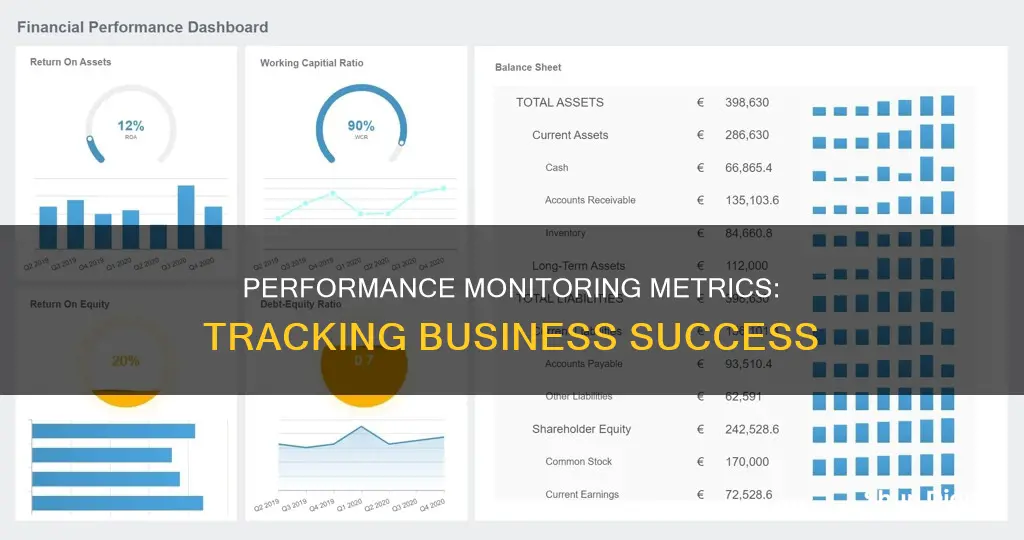
Performance monitoring metrics are the indicators used to measure and track the performance of a business or application. For businesses, these metrics are measurable data used to track processes within the company, using activities, employee behaviour and productivity as key metrics. For applications, performance monitoring metrics are used to measure the performance, reliability and user experience of the application. Performance monitoring metrics are important because they allow businesses and developers to identify issues, troubleshoot and remediate them, and ensure optimal performance.
What You'll Learn

Business performance metrics
- Sales and topline revenue generation capacity: Number of goods sold x price per item
- Return on investment (ROI): (Net profit or loss / project cost) / 100
- Employee turnover rate: (Employees who left during a specific time period / average number of employees) x 100
- Total direct costs incurred by manufacturing or procuring finished goods sold in a given period: Beginning inventory costs + purchases during the period – ending inventory value
- Customer satisfaction rate: (Total number of customers who rank themselves as satisfied / total number of responses) x 100
- Revenue vs. forecast variance: [(Actual revenue – forecasted revenue) / actual revenue] x 100
- Strategic Process Performance Metrics: These focus on whether the organization is achieving the objectives set by senior management.
- Process Performance Metrics: These focus on how a task is being performed by measuring performance and whether individual goals are being achieved.
Additionally, business performance metrics can be classified as either leading or lagging indicators of business trends. Leading indicators are forward-looking metrics that help forecast and make strategic adjustments, while lagging indicators provide information about past performance and hold employees and departments accountable for outcomes.
Monitor Size Requirements for Smooth QuickBooks Operations
You may want to see also

Sales performance metrics
Performance monitoring metrics are measurable data used to track processes within a business. They are used to evaluate employee behaviour and productivity and track the achievement of overall business goals.
Quantity metrics evaluate the volume of sales activities, providing a numerical snapshot of operations. This includes the number of calls made, the number of deals closed, and the average deal size.
Quality metrics show how effective a salesperson is at converting leads and provide insight into leadership quality. Examples of quality metrics include the win rate, conversation rate, customer satisfaction (CSAT), and net promoter score.
Efficiency metrics assess the speed and effectiveness of the sales processes, highlighting areas for streamlining and improvement. This includes sales cycle length, lead response time, and sales linearity.
Productivity metrics measure the value of sales efforts and how much money is being generated in return. Examples of productivity metrics include annual recurring revenue, average revenue per user, average profit margin, and net retention percentage.
Monitoring Home Electricity Usage: A Continuous Guide
You may want to see also

Project management performance metrics
Performance monitoring metrics are essential for project management, providing data-driven insights to track and improve project performance. They offer a comprehensive view of project health, enabling proactive problem-solving and informed decision-making. Here are some critical project management performance metrics:
Cost Variance
Tracking cost variance, the difference between the planned budget (earned value) and actual project costs, is crucial. It allows project managers to identify if they are over or under budget and make necessary adjustments. This metric helps prevent the challenging situation of requesting additional funds from clients and ensures financial transparency.
Gross Profit Margin
Gross profit margin analysis compares revenue and project expenses, providing insight into the financial performance of a project. This metric helps determine the return on investment (ROI) and identifies projects and clients that offer the most value. It is essential for making informed business decisions and understanding the financial health of a project.
Cycle Time
Cycle time refers to the duration it takes to complete tasks, sprints, or projects. Tracking this metric provides hard data for future project planning. By basing timelines on actual performance rather than estimates, project managers can optimise their team's time and set realistic deadlines that satisfy clients.
On-Time Deliveries
On-time delivery metrics measure the percentage of work delivered on or before the deadline. This metric is critical for assessing project success and client satisfaction. Additionally, tracking task ownership helps identify recurring patterns and team members who may need support or workload adjustments.
Project Scope Creep
Project scope creep is the percentage change in the original scope of work. Monitoring this metric is essential to managing resources effectively and preventing team burnout. By tracking scope creep, project managers can set realistic expectations with clients and protect the team's time by saying "no" when necessary.
Utilization Rates
Utilization rates reflect the percentage of time team members spend working relative to their availability. Optimal utilization is critical to project success. Overbooking can lead to decreased deliverable quality and burnout, while underutilization misses opportunities for faster delivery. Monitoring utilization rates helps project managers effectively balance workloads.
Client Satisfaction
Client satisfaction is a qualitative metric, typically assessed through surveys, that gauges clients' happiness with the project process and results. Checking in with clients at the end of a project helps identify areas for improvement and strengthens working relationships. It provides valuable feedback to align with client expectations and ensure consistent revenue.
While these metrics provide a solid foundation for project management performance measurement, it is essential to tailor them to the specific needs of your industry and organisation. Additionally, selecting the right tools to collect, analyse, and report on these metrics is vital for making data-driven decisions and optimising project outcomes.
Easy Ways to Check if Your Monitor is 1080p
You may want to see also

Employee performance metrics
Performance monitoring metrics are measurable data used to track processes within a business, such as activities, employee behaviour, and productivity. They are used to measure the achievement of overall business goals. Employee performance metrics are a subset of these metrics, and they assess employees' productivity and efficiency in reaching established benchmarks that contribute to the overall growth of a business.
Work Quality Metrics
Work quality metrics reflect on the quality of an employee's performance. The most common metric is a subjective appraisal by their direct manager. An adaption of this is the 9-box grid, where an employee is assessed on performance and potential. Employees with high performance and high potential are designated to advance through the ranks as they can add more value.
Other work quality metrics include:
- Management by objectives: a way to structure the subjective appraisal of a manager by translating organisational goals into specific individual goals.
- Net promoter score: a number that represents the willingness of a client to recommend a company's service to others.
- 360-degree feedback: feedback from an employee's peers, subordinates, customers, and managers on specific topics.
- 180-degree feedback: a simpler version of the above, where feedback comes only from an employee's direct colleagues and manager.
Work Quantity Metrics
Work quantity metrics refer to the amount of work produced by an employee. They are focused on outcomes and processes and are directly measured in numbers. For example, the number of units produced per hour or the number of sales calls completed in a week.
Other work quantity metrics include:
- Task completion rate: the number of tasks or projects completed within a given timeframe.
- Number of mistakes or inaccuracies: tracks the number of mistakes or inaccuracies in an employee's work.
- Number of units produced: the number of physical units produced per hour.
- Number of sales: a simple metric to quantify a salesperson's performance.
Work Efficiency Metrics
Work efficiency metrics combine data from work quality and quantity to track the resources used to produce an output. For example, the time or money it takes to produce a product.
Work efficiency metrics include:
- Task completion time: how long it takes an employee to meet deadlines and finalise tasks while maintaining work standards.
- Absenteeism rate: the average number of days an employee was absent (minus approved absences) in a defined timeframe.
- Overtime per employee: the time an employee works above their standard contracted hours within a certain timeframe.
- Task prioritisation: the ability to organise and complete tasks based on urgency and importance.
Organisational Performance Metrics
Organisational performance metrics assess a company's overall efficiency and competitiveness by evaluating the collective performance of the workforce.
Examples of organisational performance metrics include:
- Revenue per employee: calculates the average revenue generated per person within a specific time frame.
- Profit per employee: a similar metric that focuses on profit instead of revenue.
- Human Capital ROI: assesses the value of human capital by calculating the company's revenue and dividing it by the total compensation and benefit cost paid to employees.
- Employee retention rate: a metric that assesses employee retention.
Cleaning Your Monitor: Removing Internal Dirt and Grime
You may want to see also

Application performance metrics
Application performance monitoring (APM) is the strategy and practice of continuously monitoring and tracking application performance and availability, as well as end-user experience. APM solutions enable IT and DevOps teams to detect anomalies, understand trends, optimise resource usage, and troubleshoot performance issues before they impact end users.
There are two types of metrics that APM tools measure: those that show how end-users experience app performance and those that monitor infrastructure resources.
- User Satisfaction/Apdex Scores: Apdex is a measurement of user satisfaction based on the response time of requests when interacting with an application. It buckets transactions into satisfied (fast), tolerating (sluggish), too slow, and failed requests, and then applies a formula to provide a score from 0 to 1.
- Average Response Time: While averages are not always the best indicator, they are still a useful metric. It is important to monitor error rates and ensure users do not encounter errors. There are three ways to do this: HTTP Error % (number of web requests that ended in an error); Logged Exceptions (number of unhandled and logged errors); and Thrown Exceptions (number of all exceptions).
- Count of Application Instances: If an application scales up and down in the cloud, it is important to know how many server/application instances are running. This can be influenced by auto-scaling, which ensures the application scales to meet demand.
- Request Rates: Request rates can be useful to correlate with other metrics to understand how an application scales. Monitoring request rates can also help identify spikes or inactivity, which could indicate a problem. A similar metric is the number of concurrent users.
- Application & Server CPU: Monitoring CPU usage is critical as extremely high usage will lead to application performance problems.
- Application Availability/Uptime (SLAs): Monitoring application availability is key, and most companies use this to measure uptime for service level agreements. For web applications, this can be done via a simple scheduled HTTP check.
- Garbage Collection: Garbage collection can cause a process to suspend and use a lot of CPU. While not an obvious performance metric, it can be a hidden performance problem and should be monitored.
- Memory Usage: Monitoring memory usage is vital as it helps gauge how an application manages and consumes resources. High memory usage can affect performance and scalability, leading to slower response time, increased latency, crashes, and potential downtime. It can also have financial implications, such as additional infrastructure costs.
- Throughput: Throughput measures the number of transactions or requests an application can process within a given timeframe, indicating how well it handles high volumes. While various factors like memory, disk I/O, and network bandwidth influence throughput, it is still an interesting metric to track, especially for benchmarking and identifying resource limitations.
Astro Headphones and Asus Monitors: Easy Setup Guide
You may want to see also
Frequently asked questions
Performance monitoring metrics are measurable data used to track processes within a business. They can be used to monitor employee behaviour and productivity, as well as to assess whether target objectives and goals are being met.
Examples of performance monitoring metrics include productivity, profit margin, scope and cost.
Performance monitoring metrics can help businesses identify what is driving growth and profit. They can also help businesses implement strategies to meet objectives and make improvements.







